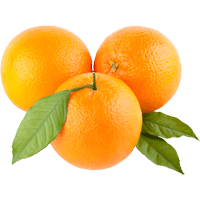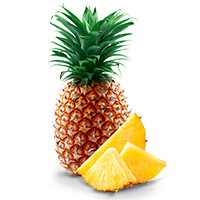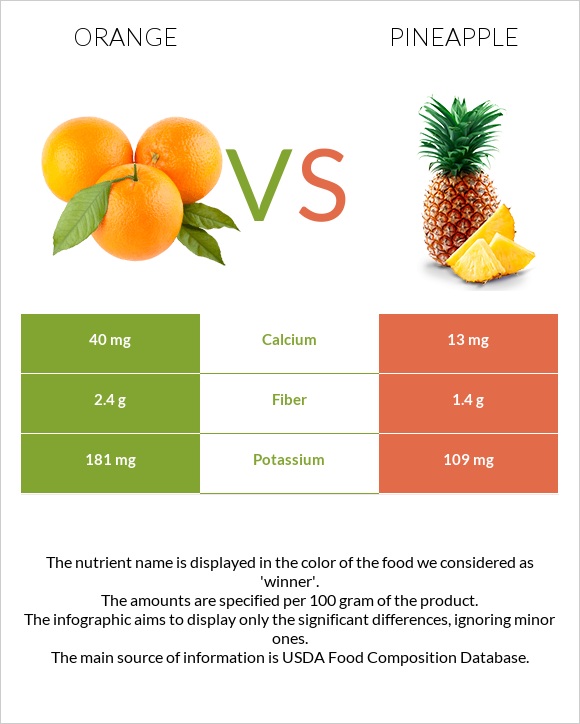Does Pineapple Juice Have More Vitamin C Than Orange Juice

vs

If you came here searching for Orange juice vs. pineapple juice, please visit this link.
Summary
Orange is richer in potassium, fiber, vitamin C and has a lower glycemic index. In comparison, pineapple is richer in manganese and copper. Oranges have adverse effects on medications, whereas pineapples improve the absorption of medications.
Pineapple is a better immune booster. Oranges are cheaper and more available.
Table of contents
- Introduction
- Culinary world
- Nutritional data comparison
- Glycemic index
- Calories
- Carbs
- Fiber
- Proteins
- Fat
- Vitamins
- Vitamin C
- Minerals
- Diets and weight loss
- Vegan
- Keto
- The pineapple diet
- Health impacts
- Cardiovascular health
- Diabetes
- Mental health and nervous system
- Obesity
- Drug interactions
- Immunity
- References
Introduction
Orange is a citrus fruit that is a hybrid between a pomelo and a mandarin. Thus, oranges are a human product of genetic crossing.
The origin of oranges is tracked to China nearly 300BC, and they were primarily found in India, China, and Myanmar. Nowadays, it is found in nearly all coastal, tropical, and subtropical regions.
To answer the mind-bending question about which came first, the color or the fruit, the answer is the fruit.
There are different types of oranges that have distinct flavors, acidity, and seasonal availability. In this article, we will take into consideration the average type of oranges that are mostly available in the market.
In this article, we will be comparing oranges with pineapples which are also known as ananas. Pineapples have originated in the southern American continent and were introduced in Europe in the 18th century. It was considered a luxury fruit.
Pineapples are considered in most countries as luxurious fruit because of their price and availability.
Pineapples are more expensive compared to oranges.
Culinary world
Oranges are consumed in various ways, and they can be eaten raw, squeezed into juice, or processed into marmalades. They are also used in cooking. For example, orange chicken is a famous Chinese takeout dish.
Pineapples are also eaten raw, made into juice, and are found in canned forms usually concentrated with sugar. A famous yet controversial usage of pineapple in cooking is Hawaiian pizza. Pineapple is also used in some Asian cuisines; for example, sweet and sour chicken is another famous Chinese takeout dish.
Nutritional data comparison
Orange and pineapples are mostly made up of water since nearly 87% of their weight are water. In this section, we will discuss the nutritional data comparison between orange and pineapple focusing on their difference. The data comparison is based on 100g of serving size for each.
Glycemic index
Orange has a lower glycemic index compared to pineapple. Orange has a glycemic index of 45 and is classified as a low glycemic index fruit. In comparison, pineapple has a glycemic index of 66 and is classified as a medium glycemic index fruit.
Calories
Orange and pineapple have similar calories since 100g of oranges are 47 calories, slightly lower than pineapple, which has 50 calories.
Carbs
Pineapples are higher in carbs compared to oranges. The difference is not that big since they mostly cover 4% of the daily value of carbs.
Fiber
Oranges are richer in fibers compared to pineapple, given that they satisfy nearly 8% of the daily value of fibers. On the other hand, pineapple has nearly half the amount of fibers, satisfying only 4% of the daily value of fiber.
Proteins
Both oranges and pineapples are not high in protein since oranges contain 1g of protein, whereas pineapple contains even less, 0.5g.
Fat
They contain negligible amounts of fats.
Vitamins
Orange is richer in vitamin B1, folate, and vitamin C. On the other hand, pineapple is richer in vitamin B6.
Vitamin C
Orange is famous for being a good vitamin C. Orange is richer in vitamin C than pineapple and satisfies nearly 88% of the daily value.
Pineapples are high in vitamins but only satisfy 80% of the daily value.
We can conclude that they are both rich in vitamin C. However, comparatively speaking, orange is richer.
Vitamin Comparison
Vitamin comparison score is based on the number of vitamins by which one or the other food is richer. The "coverage" chart below show how much of the daily needs can be covered by 300 grams of the food
![]()
7
:
3
![]()
Contains more Vitamin C +11.3%
Contains more Vitamin A +287.9%
Contains more Vitamin E +800%
Contains more Vitamin B1 +10.1%
Contains more Vitamin B2 +25%
Contains more Vitamin B5 +17.4%
Contains more Folate +66.7%
Contains more Vitamin B3 +77.3%
Contains more Vitamin B6 +86.7%
Contains more Vitamin K +∞%
Equal in Vitamin B1 - 0.079
Contains more Vitamin C +11.3%
Contains more Vitamin A +287.9%
Contains more Vitamin E +800%
Contains more Vitamin B1 +10.1%
Contains more Vitamin B2 +25%
Contains more Vitamin B5 +17.4%
Contains more Folate +66.7%
Contains more Vitamin B3 +77.3%
Contains more Vitamin B6 +86.7%
Contains more Vitamin K +∞%
Equal in Vitamin B1 - 0.079
Minerals
Orange is richer in potassium, whereas pineapple is richer in manganese and copper.
They are both low in sodium.
Mineral Comparison
Mineral comparison score is based on the number of minerals by which one or the other food is richer. The "coverage" chart below show how much of the daily needs can be covered by 300 grams of the food
![]()
4
:
4
![]()
Contains more Calcium +207.7%
Contains more Potassium +66.1%
Contains more Phosphorus +75%
Contains less Sodium -100%
Contains more Iron +190%
Contains more Magnesium +20%
Contains more Copper +144.4%
Contains more Zinc +71.4%
Contains more Calcium +207.7%
Contains more Potassium +66.1%
Contains more Phosphorus +75%
Contains less Sodium -100%
Contains more Iron +190%
Contains more Magnesium +20%
Contains more Copper +144.4%
Contains more Zinc +71.4%
Diets and weight loss
Orange and pineapple are low in calories and low in carbs. They are filled with vitamins, fibers and are mostly water.
They will keep you hydrated and full for longer durations, thus inducing weight loss over the long term.
Vegan
Orange and pineapple are recommended to be consumed in vegan diets. They can be used in main dishes, as mentioned in the introduction section. They can also be used as toppings in breakfast bowls or consumed as snacks.
Keto
Oranges and pineapples are not recommended to be consumed in keto diets. They are high in carbs relative to amounts allowed in the keto diet.
The pineapple diet
There is a diet called the pineapple diet that is usually done over 5 days. This diet consists of eating solid pineapple for 5 days without eating any other solid food. However, this is not a very recommended diet from a medical perspective and is considered a bad diet.
Health impacts
Cardiovascular health
Eating oranges frequently decreased amounts of lipid peroxidation and increased total amounts of antioxidants in the blood. Lowering risks of developing cardiovascular diseases. (1)
Pineapple contains an enzyme called bromelain, which has protective roles against cardiovascular diseases. An overall decrease in cardiovascular health diseases was reduced.
(2)
Diabetes
In nondiabetic individuals, consuming oranges did not cause increased sugar levels in the blood. There is no association between oranges and developing type 2 diabetes. (3)
In diabetic patients, pineapple consumption in moderate amounts helps control blood glucose levels and improves absorbing the medications. (4)
Mental health and nervous system
Consuming orange, which is high in flavonoids, has shown a protective role against depression among older women. (5)
Pineapple extracts such as ethanolic compounds have a beneficial effect on scopolamine-induced memory impairment. Thus positively affecting memory and learning. (6)
Obesity
Consuming oranges have proven to lower the risks of obesity. (7)
Eating pineapples is associated with increased fat metabolism (lipolysis) and decreased fat deposition (fat deposition). (8)
Drug interactions
Oranges interact with the absorption of atenolol which is a beta-blocker taken during hypertension. Oranges should not be associated with atenolol. (9)
Pineapple has positive effects that interact with 2 medications, celecoxib and anti-inflammatory drug and montelukast, a drug for asthma. They enhance the pharmacokinetic effects of these 2 drugs. (10)
Bromelain, which is found in pineapple, interacts with certain drugs. It increases the absorption of antibiotics like Amoxil and tetracyclines. This improves the antibiotic functions though it increases the intensity of side effects if present. Bromelain interacts with anticoagulants. Meaning that bromelain has blood-thinning properties that should be taken into consideration while taking blood thinners. (11)
Immunity
Orange has an immune-boosting effect. They induce the response of immune cells to enhance their action towards infectious agents. Thus, usually prescribed in infections to saturate the body with vitamin C to show maximal beneficial characteristics. (12)
Pineapples contain bromelain, which has immunomodulatory roles, thus improving overall immunity. Immunomodulators are responsible for regulating and normalizing the immune system. (13)
Pineapples are also rich in vitamin C, thus having a similar effect to oranges in immune-boosting effects.
References
- https://pubmed.ncbi.nlm.nih.gov/24476220/
- https://www.ncbi.nlm.nih.gov/pmc/articles/PMC3529416/
- https://www.ncbi.nlm.nih.gov/pmc/articles/PMC6770506/
- https://pubmed.ncbi.nlm.nih.gov/23929507/
- https://academic.oup.com/ajcn/article/104/3/704/4564688
- https://www.ncbi.nlm.nih.gov/pmc/articles/PMC5465835/
- https://www.ncbi.nlm.nih.gov/pmc/articles/PMC3545988/
- https://www.ncbi.nlm.nih.gov/pmc/articles/PMC6170270/
- https://pubmed.ncbi.nlm.nih.gov/15983823/
- https://pubmed.ncbi.nlm.nih.gov/32507029/
- https://www.webmd.com/vitamins/ai/ingredientmono-895/bromelain
- https://pubmed.ncbi.nlm.nih.gov/29099763/
- https://www.ncbi.nlm.nih.gov/pmc/articles/PMC4998156/

Education: Haigazian Medical University
Last updated: November 23, 2021
Infographic

Vitamin and Mineral Summary Scores
The summary score is calculated by summing up the daily values contained in 300 grams of the product. Obviously the more the food fulfills human daily needs, the more the summary score is.
Vitamin Summary Score
24
![]()
21
![]()
Mineral Summary Score
8
![]()
10
![]()
Macronutrients Comparison
Macronutrient comparison charts compare the amount of protein, total fats, and total carbohydrates in 300 grams of the food. The displayed values show how much of the daily needs can be covered by 300 grams of food.
Protein
6%
![]()
3%
![]()
Carbohydrates
12%
![]()
13%
![]()
Fats
1%
![]()
1%
![]()
Which food is preferable for your diet?
![]()
![]()
is better in case of low diet
 |  | |
| Low Calories diet | | |
| Low Fats diet | Equal | |
| Low Carbs diet | | |
| Low glycemic index diet | | |
People also compare
Comparison summary
Which food is lower in Saturated Fat?
![]()
Pineapple is lower in Saturated Fat (difference - 0.006g)
Which food is lower in Sugar?
![]()
Orange is lower in Sugar (difference - 0.5g)
Which food contains less Sodium?
![]()
Orange contains less Sodium (difference - 1mg)
Which food is lower in glycemic index?
![]()
Orange is lower in glycemic index (difference - 21)
Which food is cheaper?
![]()
Orange is cheaper (difference - $0.2)
Which food is richer in vitamins?
![]()
Orange is relatively richer in vitamins
Which food contains less Cholesterol?
?
The foods are relatively equal in Cholesterol (0 mg)
Which food is richer in minerals?
?
It cannot be stated which food is richer in vitamins. See the charts below for detailed information. See the charts below for detailed information. See the charts below for detailed information.
Does Pineapple Juice Have More Vitamin C Than Orange Juice
Source: https://foodstruct.com/compare/oranges-vs-pineapple

Tidak ada komentar: